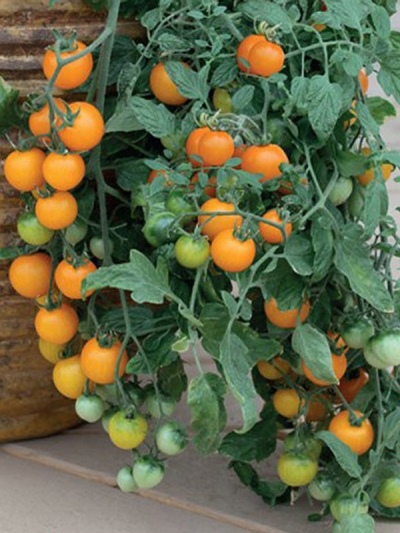
- Authors: Maksimov S.V., Tereshonkova T.A., Klimenko N.N. (LLC "Agrofirma Poisk")
- Year of approval: 2012
- Category: grade
- Growth type: determinant
- Appointment: fresh consumption, for whole fruit preservation
- Ripening period: early
- Ripening time, days: 80-85
- Growing conditions: for a balcony, for growing on a windowsill, pot culture
- Bush size: undersized
- Bush height, cm: up to 100
Ampel tomatoes allow you to get fresh fruits without having a garden plot. These crops include the Golden Bunch tomato. This is a real find for a mini-garden in a city apartment. The decorative appearance, abundant fruiting and excellent taste of the variety do not leave anyone indifferent.
Description of the variety
The determinant ampelous tomato is ideal for growing in planters, pots and special boxes. The culture feels great when placed on a windowsill or on an insulated balcony. It is also suitable for cultivation in greenhouses.
Plants grow no higher than 100 cm, have creeping stems and medium-sized green leaves. Shoots can be up to 1 meter long. The stalks are articulated.
The main qualities of the fruit
Rounded berries in the process of ripening have a light green tint and spots at the base. Reaching ripeness, the fruits acquire an even orange tone. The skin of the tomatoes is smooth. The pulp is of medium density, juicy. The average weight of one berry is 25-35 g.
Taste characteristics
The berries of the Golden Bunch tomato have a sweet taste with a slight sourness. They can be eaten fresh in light salads. And also suitable for whole-fruit canning.
Ripening and fruiting
The first crop can be harvested in July. From the moment of emergence to the formation of fruits, it takes about 80-85 days. Therefore, the variety is considered early.
Yield
Berries appear on plants in large quantities (20-30 pieces per brush). Thus, up to 2-2.5 kg of fruit can be obtained from one bush. If there are several tomatoes, the yield per square meter will be 4.7 kg.
Tomatoes are harvested as they ripen, about 1 time per week. You can remove unripe berries. They perfectly come to readiness on the windowsill in bright sunlight. To increase the storage duration, the fruits should be plucked with stalks, leaving 1-2 cm at the base.
The timing of planting seedlings and planting in the ground
Sowing seedlings is carried out in late February or early March. When 2 true leaves appear, young tomatoes dive. The transfer of the culture to a permanent place is carried out when the plants reach the age of 60 days (in late April - early May). If necessary, the transplant is carried out with an earthen lump to avoid damage to the roots. It is also possible to plant seeds directly in pots.
Representatives of the variety love light fertile loamy and sandy loam soils. Good aeration and humus enrichment is desirable. At first, the container with the plants is covered with a film. This helps to maintain the optimum moisture and temperature required for successful germination of the seed. It is important to avoid hypothermia of the seedlings.

Growing tomato seedlings is an extremely important process, because it largely depends on whether the gardener will be able to harvest at all. All aspects must be taken into account, from seedbed preparation to planting in the ground.
Landing scheme
The seeds are placed in the ground 1-2 cm.At the same time, a distance between future plants of 3 cm is observed. When moving to a permanent place, choose a capacious container. The recommended container size for one plant is at least 4 liters.

Growing and care
For uniform formation, the Golden bunch tomato is fixed in an upright position and tied to a support. Watering should be regular (2-3 times a week). In this case, moisture should be distributed evenly, without stagnation. And also it is obligatory to periodically loosen the soil to maintain its air permeability.
One of the important conditions for the successful development of this variety is the provision of a sufficient amount of light and heat. In winter, you need to highlight the culture with phyto-lamps.
Tomatoes must be fertilized with mineral complexes twice or three times a season. You can alternate them with organic. It is imperative that phosphorus and potassium enter the soil. The variety especially needs these elements.




A plant needs different micronutrients at each stage of growth. All fertilizers can be divided into two groups: mineral and organic. Folk remedies are often used: iodine, yeast, bird droppings, eggshells.
It is important to observe the rate and period of feeding. This also applies to folk remedies and organic fertilizers.
Disease and pest resistance
The variety is resistant to tobacco mosaic and fusarium. However, it is important to carefully monitor the condition of the plants and, if necessary, take appropriate action immediately.


Review overview
Everyone who is familiar with this variety is delighted with the abundant harvest of delicious fruits. There are no problems in the cultivation of the Golden Bunch tomato. At the same time, many put plants in greenhouses, and in the southern regions they even successfully grow crops in open areas. Plants are planted in open ground in early June according to the scheme of 3 bushes per 1 square meter.

























































































